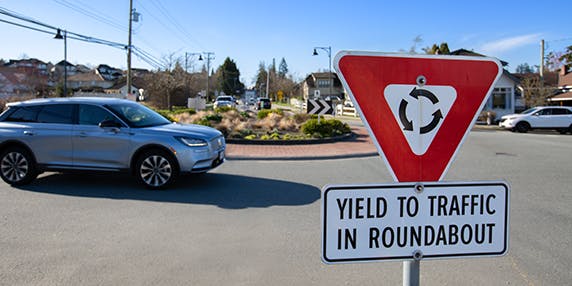Newsroom
Roundabouts reduce injury crashes by 75% but new Ipsos survey reveals some B.C. drivers lack confidence navigating them
February 07, 2024

A new ICBC survey * conducted by Ipsos reveals that just over half of drivers (57%) feel confident navigating a single-lane roundabout and 29% feel confident navigating a multi-lane roundabout.
The survey also shows that 15% of respondents find it difficult to know who has the right of way when entering a roundabout. This correlates with drivers’ biggest frustration when it comes to navigating roundabouts: other drivers not yielding to vehicles that have the right of way.
Modern roundabouts can reduce injury crashes by up to 75% as they reduce speed and eliminate head-on, right-angle and left-turn crashes.** They can also increase safety for pedestrians and cyclists.
“Road design is critical to keeping everyone on our roads safe,” said Shabnem Afzal, ICBC’s director of road safety. “Roundabouts are proven to be highly effective in reducing crashes. While common in Europe, they’re relatively newer to Canada. We’re here to offer a refresher and tips so that whether you’re walking, driving or cycling, we all know how to safely navigate roundabouts and share our roads together.”
We’ve invested more than $5 million in approximately 90 new roundabouts throughout B.C. since 2000. We work with B.C. municipalities and the provincial government to invest in road improvements like roundabouts to make our roads safer for everyone.
Follow our roundabout series on Instagram this month for videos and tips.
Tips for navigating roundabouts:
For drivers:
Slow down as you approach a roundabout and yield to pedestrians or cyclists who may be crossing or about to cross in the crosswalk ahead of the roundabout.
Make sure you know where you want to go and enter the roundabout in the correct lane. Unless lane use signs and markings indicate otherwise, the general rules for a multiple lane roundabout are as follows:
If you want to turn left, use the left lane.
If you want to turn right, use the right lane.
If you want to go straight, use the left or right lane.
Yield to any traffic already in the roundabout. Go around the roundabout in a counter-clockwise direction. You may not change lanes in a multi-lane roundabout.
Don’t drive alongside large vehicles such as trucks and buses in roundabouts. They may need more than their lane to go through the roundabout.
Signal “right” before you exit so that drivers waiting to enter and pedestrians waiting to cross know your intentions. Be prepared to yield to pedestrians or cyclists who may be in the crosswalk when you’re exiting.
If an emergency vehicle approaches and you're already in the roundabout, finish driving through it and pull over upon exiting so the emergency vehicle can pass.
For cyclists:
You may either cycle through a roundabout with vehicle traffic or use the pedestrian paths.
If you want to cycle with vehicle traffic, before reaching the roundabout, merge with traffic when safe and follow the same rules as vehicles inside the roundabout. Stay in the middle of your lane to avoid collisions with vehicles turning right.
If you want to use the pedestrian paths, before reaching the roundabout, exit the bike lane, dismount on the sidewalk and continue through as a pedestrian.
Some roundabouts have multi-use paths where you may continue cycling alongside pedestrians. Be aware of pedestrians you're sharing the path with and make sure to reduce your speed when entering onto and travelling along the multi-use path.
When exiting the roundabout, use the raised pathway at the ramp that leads down to the bike lane or the shoulder of the road on the exit.
For pedestrians:
Pedestrian crosswalks are marked approximately one car length away from the roundabout. You should cross only at these crosswalks. Never cross to the centre island.
Don't start crossing until you know it's safe, which means that there's enough of a gap in incoming traffic or that all approaching vehicles have stopped.
Pedestrian crosswalks may also be connected to a multi-use path. If you see one, be aware that you're sharing the crosswalk and paths with cyclists.
*Survey conducted by Ipsos. Total respondents = 801; completed surveys = 636. Data collected from January 2 to 5, 2024. Those who did not have a valid B.C. driver’s licence and/or have never driven through a roundabout were screened out (165).
**Roundabouts can reduce injury crashes by approximately 75%. The Canadian Roundabout Design Guide (Transportation Association of Canada, 2017) Section 5.1.1.
